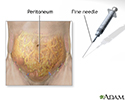Abdominal tap
Peritoneal tap; Paracentesis; Ascites - abdominal tap; Cirrhosis - abdominal tap; Malignant ascites - abdominal tap
An abdominal tap is used to remove fluid from the area between the belly wall and the spine. This space is called the abdominal cavity.
How the Test is Performed
This test may be done in a health care provider's office, treatment room, or hospital.
The puncture site will be cleaned and shaved, if necessary. You then receive a local numbing medicine. The tap needle is inserted 1 to 2 inches (2.5 to 5 cm) into the abdomen. Sometimes, a small cut is made to help insert the needle. The fluid is pulled out into a syringe.
The needle is removed. A dressing is placed on the puncture site. If a cut was made, one or two stitches may be used to close it.
Sometimes, ultrasound is used to guide the needle. An ultrasound uses sound waves to make the image and not x-rays. It does not hurt.
There are 2 kinds of abdominal taps:
- Diagnostic tap. A small amount of fluid is taken and sent to the laboratory for testing
- Large volume tap. Several liters may be removed to relieve abdominal pain and fluid buildup
How to Prepare for the Test
Let your provider know if you:
- Have any allergies to medicines or numbing medicine
- Are taking any medicines (including herbal remedies)
- Have any bleeding problems
- Might be pregnant
How the Test will Feel
You may feel a slight sting from the numbing medicine, or pressure as the needle is inserted.
If a large amount of fluid is taken out, you may feel dizzy or lightheaded. Tell the provider if you feel dizzy or lightheaded.
Why the Test is Performed
Normally, the abdominal cavity contains only a small amount of fluid. In certain conditions, large amounts of fluid can build up in this space.
An abdominal tap can help diagnose the cause of fluid buildup or the presence of an infection. It may also be done to remove a large amount of fluid to reduce belly pain.
Normal Results
Normally, there should be little or no fluid in the abdominal space.
What Abnormal Results Mean
An exam of abdominal fluid may show:
-
Cancer that has spread to the abdominal cavity (
most often cancer of the ovaries
)
Most often cancer of the ovaries
Ovarian cancer is cancer that starts in the ovaries. The ovaries are the female reproductive organs that produce eggs.
 ImageRead Article Now Book Mark Article
ImageRead Article Now Book Mark Article -
Cirrhosis of the liver
Cirrhosis of the liver
Cirrhosis is scarring of the liver and poor liver function. It is the last stage of chronic liver disease.
 ImageRead Article Now Book Mark Article
ImageRead Article Now Book Mark Article - Damaged bowel
- Heart disease
- Infection
- Kidney disease
- Pancreatic disease
Risks
There is a slight chance that the needle could puncture the bowel, bladder, or a blood vessel in the abdomen. If a large quantity of fluid is removed, there is a slight risk of lowered blood pressure and kidney failure. There is also a slight chance of infection.
References
Garcia-Tiso G. Cirrhosis and its sequelae. In: Goldman L, Schafer AI, eds. Goldman's Cecil Medicine . 25th ed. Philadelphia, PA: Elsevier Saunders; 2016:chap 153.
Runyon BA. Ascites and spontaneous bacterial peritonitis. In: Feldman M, Friedman LS, Brandt LJ, eds. Sleisenger & Fordtran's Gastrointestinal and Liver Disease . 10th ed. Philadelphia, PA: Elsevier Saunders; 2016:chap 93.
-
Digestive system - illustration
The esophagus, stomach, large and small intestine, aided by the liver, gallbladder and pancreas convert the nutritive components of food into energy and break down the non-nutritive components into waste to be excreted.
Digestive system
illustration
-
Peritoneal sample - illustration
The peritoneum is the membrane lining the abdominal cavity.
Peritoneal sample
illustration
-
Digestive system - illustration
The esophagus, stomach, large and small intestine, aided by the liver, gallbladder and pancreas convert the nutritive components of food into energy and break down the non-nutritive components into waste to be excreted.
Digestive system
illustration
-
Peritoneal sample - illustration
The peritoneum is the membrane lining the abdominal cavity.
Peritoneal sample
illustration
Review Date: 7/22/2016
Reviewed By: Subodh K. Lal, MD, gastroenterologist with Gastrointestinal Specialists of Georgia, Austell, GA. Review provided by VeriMed Healthcare Network. Also reviewed by David Zieve, MD, MHA, Isla Ogilvie, PhD, and the A.D.A.M. Editorial team.


